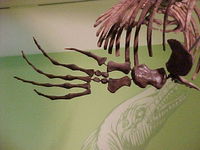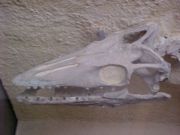|
Plioplatecarpinae Conservation status: Fossil |
||||||||||||
|---|---|---|---|---|---|---|---|---|---|---|---|---|

Forelimb of Platecarpus tympaniticus.
|
||||||||||||
| Scientific classification | ||||||||||||
|
||||||||||||
| See text. |
Plioplatecarpinae (Dollo, 1884; Williston, 1897) is a subfamily of mosasaurs, a diverse group of Late Cretaceous marine squamates.
Russell (1967, pp. 148) defined the Plioplatecarpinae as follows: Small rostrum present or absent anterior to premaxillary teeth. Cranial nerves X, XI, XII leave lateral wall of opisthotic through single foramen. Canal or deep groove in floor of basioccipital and basispehnoid for basilar artery. Suprastapedial process of quadrate large, bluntly terminated and with parallel sides. Dorsal edge of surangular rounded and longitudinally horizontal...Twenty-nine or less presacral vertebrae present. Length of presacral series less than that of postsacral, neural spines of posterior caudal vertebrae at most only slightly elongated, do not form an appreciable fin. Haemal arches usually unfused to caudal centra. Appendicular elements lack smoothly finished articular surfaces."

Genera referrable to the Plioplatecarpinae (informally and collectively known as "plioplatecarpines") have been found on all continents, though the occurrences in Australia remain questionable. The etymology of the subfamily is derived from one of its members, Plioplatecarpus: Greek pleion = "more" + Greek plate = "oar" + Greek karpos = "wrist, carpus"). In general, plioplatecarpines were short-skulled, short-bodied forms and were among the strongest swimming mosasaurs. Some workers have likened them to pinnipeds in their agility. Most forms were likely piscivores ("fish eaters"), though cephalopods (belemnites) evidently formed an important part of the plioplatecarpine diet. Larger forms may have also fed upon smaller marine reptiles. At least one genus evolved sturdy crushing teeth adapted to feeding on shellfish. The plioplatecarpines were medium-sized mosasaursm ranging from 12-25 feet ion length. Russell (1967) included two tribes, the Plioplatecarpini and Prognathodontini, the latter of which has been reassigned by Bell (1997) to the Mosasaurinae.
Polcyn and Bell (2005, p. 322) have erected a more inclusive clade, the parafamily Russellosaurina, which includes the "subfamilies Tylosaurinae and Plioplatecarpini and their sister-clade containing the genera Tethysaurus, Russellosaurus, and Yaguarasaurus."
The first plioplatecarpines appear in the Turonian and are among the oldest of mosasaurs, and the clade persists throughout the Maastrichtian, a period of approximately 24 million years.
Species and Taxonomy
- Plioplatecarpinae
- Plioplatecarpini
- Platecarpus (paraphyletic)
- P. tympaniticus (=P. coryphaeus, P. ictericus; Kiernan 2002)
- P. planifrons
- P. bocagei (=Angolasaurus; Lingham-Solair 1994)
- Ectenosaurus
- E. clidastoides
-
Selmasaurus
- S. russelli
- Igdamanosaurus
- I. aegyptiacus
- Yaguarasaurus
- Y. colombianus
- Plioplatecarpus
- P. primaevus
- P. houzeaui
- P. marshii
- Platecarpus (paraphyletic)
- Plioplatecarpini
References
- Dollo, L. 1884. Le mosasaure. Revue des Questions Scientifiques XVI:648-653.
- Bell, G. L. Jr., 1997. A phylogenetic revision of North American and Adriatic Mosasauroidea. pp. 293-332 In Callaway J. M. and E. L Nicholls, (eds.), Ancient Marine Reptiles, Academic Press, 501 pp.
- Kiernan, C. R., 2002. Stratigraphic distribution and habitat segregation of mosasaurs in the Upper Cretaceous of western and central Alabama, with an historical review of Alabama mosasaur discoveries. Journal of Vertebrate Paleontology 22(1):91-103.
- Lingham-Soliar, T. 1994. The mosasaur "Angolasaurus" bocagei (Reptilia: Mosasauridae) from the Turonian of Angola re-interpreted as the earliest member of the genus Platecarpus. Palaeont. Z. 68:1/2:267-282.
- Polcyn, M. J. et Bell, G. L., Jr. 2005. Russellosaurus coheni n. gen., n. sp., a 92 million-year-old mosasaur from Texas (USA), and the definition of the parafamily Russellosaurina. Netherlands Journal of Geosciences 84(3): 321-333.
- Russell, D. A., 1967. Systematics and morphology of American mosasaurs. Peabody Museum of Natural History, Yale University, Bulletin 23.
- Williston, S. W. 1897. Range and distribution of the mosasaurs with remarks on synonymy. Kansas University Quarterly 4(4):177-185.